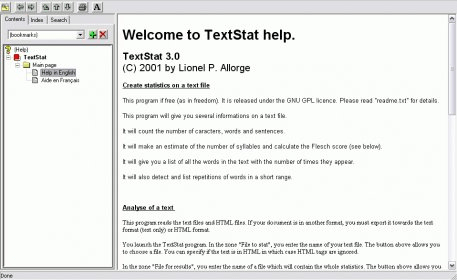Apr 25, 2016 TextSTAT 2.9c for Windows (ZIP file, approx. 8 MB, Feb 20, 2014) This version includes everything you need to use TextSTAT with Windows. It comes as a single installation file. To install the programme, just unpack the file to a directory of your choice. To run TextSTAT, change to that directory and doubleclick on 'TextSTAT.exe'. Apr 25, 2016 TextSTAT is a simple programme for the analysis of texts. It reads plain text files (in different encodings) and HTML files (directly from the internet) and it produces word frequency lists and concordances from these files. Textstatfrequency: Tabulate feature frequencies Description Produces counts and document frequencies summaries of the features in a dfm, optionally grouped by a docvars variable or other supplied grouping variable. Nov 22, 2020 Textstat. Textstat is an easy to use library to calculate statistics from text. It helps determine readability, complexity, and grade level. Photo by Patrick Tomasso on Unsplash.

Description
Produces counts and document frequencies summaries of the features in adfm, optionally grouped by a docvars variable or other suppliedgrouping variable.
Usage
Textstat is an easy to use library to calculate statistics from text. It helps determine readability, complexity, and grade level. Photo by Patrick Tomasso on Unsplash.
Arguments

a dfm object
(optional) integer specifying the top n features to be returned,within group if groups is specified
either: a character vector containing the names of documentvariables to be used for grouping; or a factor or object that can becoerced into a factor equal in length or rows to the number of documents.NA values of the grouping value are dropped.See groups for details.
character string specifying how ties are treated. Seedata.table::frank() for details. Unlike that function,however, the default is 'min', so that frequencies of 10, 10, 11would be ranked 1, 1, 3.
additional arguments passed to dfm_group(). This canbe useful in passing force = TRUE, for instance, if you are grouping adfm that has been weighted.


Value
a data.frame containing the following variables:
feature(character) the feature
frequencycount of the feature
rankrank of the feature, where 1 indicates the greatestfrequency
docfreqdocument frequency of the feature, as a count (thenumber of documents in which this feature occurred at least once)

docfreqUsing Text String Within Formula In Excel
document frequency of the feature, as a count
group(only if groups is specified) the label of the group.If the features have been grouped, then all counts, ranks, and documentfrequencies are within group. If groups is not specified, the groupcolumn is omitted from the returned data.frame.
Using Textstat To Use
textstat_frequency returns a data.frame of features andtheir term and document frequencies within groups.